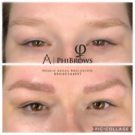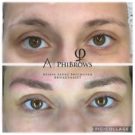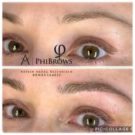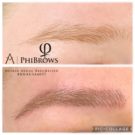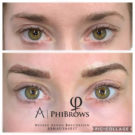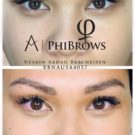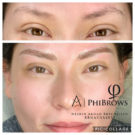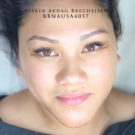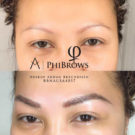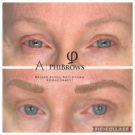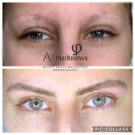
What is Microblading?
Microblading, also known as eyebrow embroidery or 3D brows, is a relatively new manual method for enhancing eyebrows. It is considered to be permanent makeup, as compared to the traditional hair stroke technique done by machine. It is done using a handheld tool (pen) with a very fine needle grouping to deposit pigment into the dermis. Because the color is closer to the surface, the strokes appear crisp and very fine. There is no spilling under the skin.
The difference with this and ordinary permanent makeup is that microblading is not done by a machine. The pigment is manually placed into the skin. The microblading manual pen is equipped with sterile packaged blades. The needle grouping glides with gentle pressure over the skin and causes fine cuts, as fine as a paper cut, leaving a trace that can hardly be distinguished from real hair. Depending on the drawing technique – of which we are experts – it creates an individual look perfect for your face and the style you are trying to achieve. The eyebrows absolutely do not appear as a tattoo, they look like real hair. Check out the video above of a customer’s reaction.
Microblading is ideal for anyone wanting to enhance the look of their eyebrows. The results are natural looking hair-like strokes, regardless of the amount of the hair you currently have.
People suffering from alopecia, trichotillomania or any other condition that causes hair loss benefit greatly from microblading, as well as people who simply aren’t happy with their eyebrows.
Why Choose a PhiBrows Artist?
Phibrows artists produce great work because they follow a very specific method that is taught to them through a rigorous 6 month training course. This course requires the artist to pass 11 levels of mastery to ensure that their methods and their work maintain a very high standard… the Phibrows standard.
The Phibrows method and tools have been meticulously designed and redesigned to aid their trained artists in producing very precise hairstrokes, perfect symmetry, and a beautiful eyebrow shape that goes with the natural shape of their client’s face and bone structure.
Phibrows products have also been tested and redesigned again and again to ensure the highest quality, to avoid any dangerous heavy metals found in most permanent makeup pigments and to provide color that stays.
It is for these reasons and more, that if you want great results with your microblading treatment, it is highly recommended that you seek out a Phibrows artist.
FAQ’s
How long does the treatment take?
Usually Microblading is done in two sessions. The first, takes two to three hours. In the first session, the brow is shaped and styled to the client’s preference, and pigment is applied. Four to six weeks later, the client returns for the second session (touch up) and this can last one to two hours.
How long does microblading take to heal?
It takes about ten days for healing. In that time, any redness will fade and the initial darkness of the eyebrows will begin to lighten. The color will lighten over about thirty days as it completely sets in.
Why is it necessary to do a touch up?
Touch up is necessary because everyone heals differently and therefore the outcomes vary. Sometimes it is necessary to adjust the color and brow thickness by adding more strokes. In the touch up session, the final adjustments are made to assure the client’s satisfaction.
Can the touch up be done in less than four weeks?
This is not recommended because the healing needs to be completed before the final results are seen. Final adjustments should only be done after the initial work has stabilized.
Is Microblading painful?
The level of discomfort is relatively minor. Some liken it to tweezing two to three hairs at the same time. A topical anesthetic can be used to numb the area being worked if necessary. Topical anesthetics are safe and may contain lidocaine, tetracaine and epinephrine.
Redness and slight swelling in the area is common after the procedure. Often clients liken the feeling to a slight sunburn. Frequently Tylenol is used to deaden any discomfort.
How long does Microblading last?
Generally Microblading lasts six to eighteen months, depending on skin type (normal, oily, or dry), age, and how well pre and post-care instructions are followed. It is not permanent like a tattoo, because the pigments are not implanted so deeply into the skin, so skincare also affects the duration of the pigments. To maintain the brows, touch may be done every six to eighteen months.
Are there any pre-care instructions?
Prior to the start of your session, avoid alcohol, aspirin, ibuprofen and any vitamins for seventy-two hours. Sometimes these have the effect of thinning your blood.
Avoid tanning to allow your natural skin tone to be assessed.
Are there any post-procedure instructions?
Gently clean brows using a Q-tip lightly moistened with water.
Gently wipe away Skin Candy (healing balm) and any lymphatic liquid (clear yellowish buildup) that may have occurred on the skin.
Re-apply skin candy (healing balm) after lightly cleaning with a tissue.
Apply a light layer of skin candy morning and night to brows for five to seven days.
Do not over apply Skin Candy.
Do not immerse brows in water for two weeks.
Avoid face area when showering.
When washing your face, make sure to avoid brows.
Do not use makeup on the brows for up to two weeks.
Avoid alcohol, aspirin, ibuprofen and vitamins that may cause your blood to thin for twenty-four hours.
Do not peel or scratch at the scabbing as your brow area heals.
No swimming, tanning or saunas for two weeks.
No face scrubs or chemical peels for two weeks.
Who should NOT have Microblading?
Those using Accutane
Anyone with a heart condition or is using heart medications
Anyone with diabetes will need a physician’s approval.
Anyone with skin diseases or inflammations.
Anyone who had Botox in the last two weeks.
Anyone who has gotten a deep tan or chemical peel in the last two weeks.
Anyone who requires anesthetic and is allergic to lidocaine, tetracaine, or epinephrine.
Anyone with serious medical conditions should consult with their doctors and obtain their approval.
Anyone pregnant or nursing should get their doctor’s approval.
Anyone on blood thinning medications.
What are some of the risks and complications with Microblading?
Proper procedures and precautions are used to ensure safe procedures. Either sterilized tools or disposable tools are used in a sanitized environment. When pre and post care instructions are followed, the risk of complications are minimal. Allergic reactions to pigments are very rare, but sometimes occur. For this reason, a pigment patch test for those with sensitive skin or to topical makeup product, gold , silver, nickel, or hair dyes should be patch tested a few days in advance of the procedure.
What if I don’t like the result?
Carefully choose your practitioner. Compare the work of various artists before choosing. Discuss your expectations and desired outcome, including the shape, style, and color you wish with the artist. Realize that faces are never perfectly symmetrical. Adjustments may be made during touch up, such as pigment discoloration and color correction. Remember that Microbladed brows will eventually fade away if touch ups are not done.

